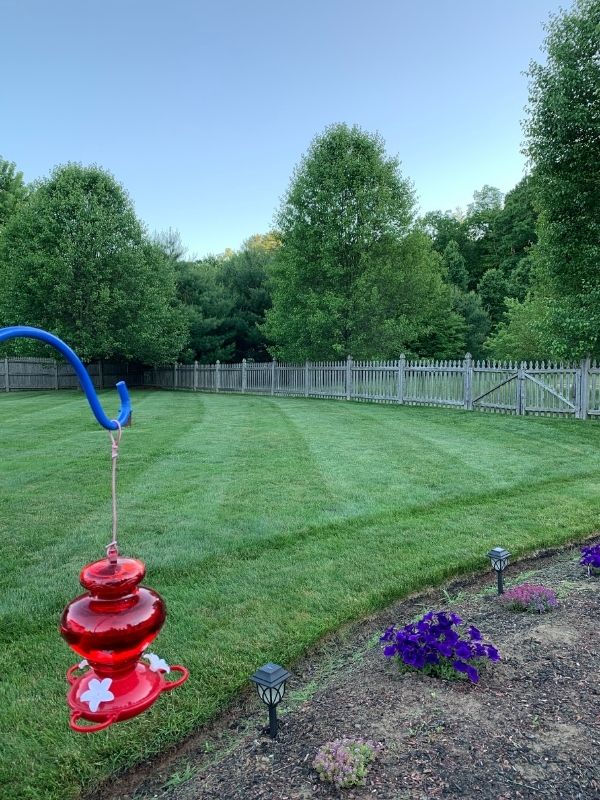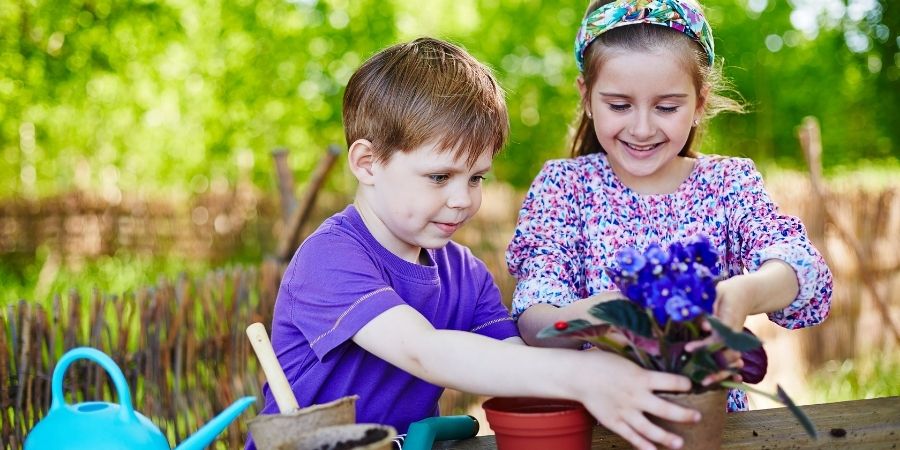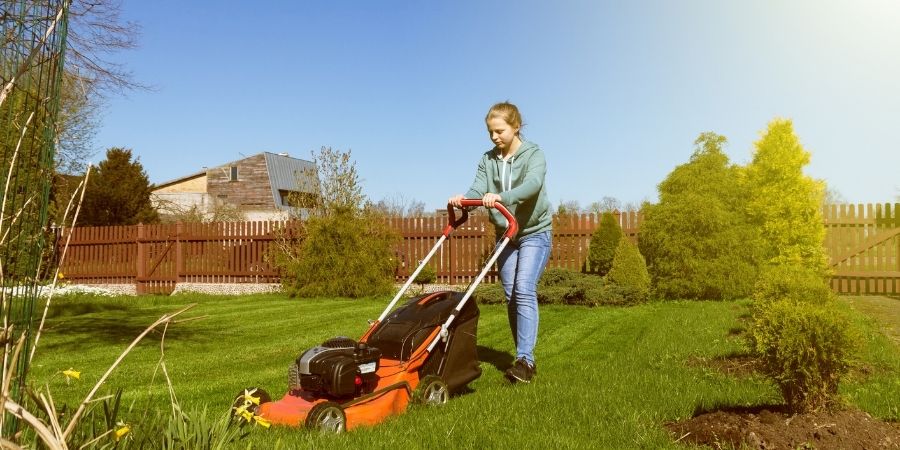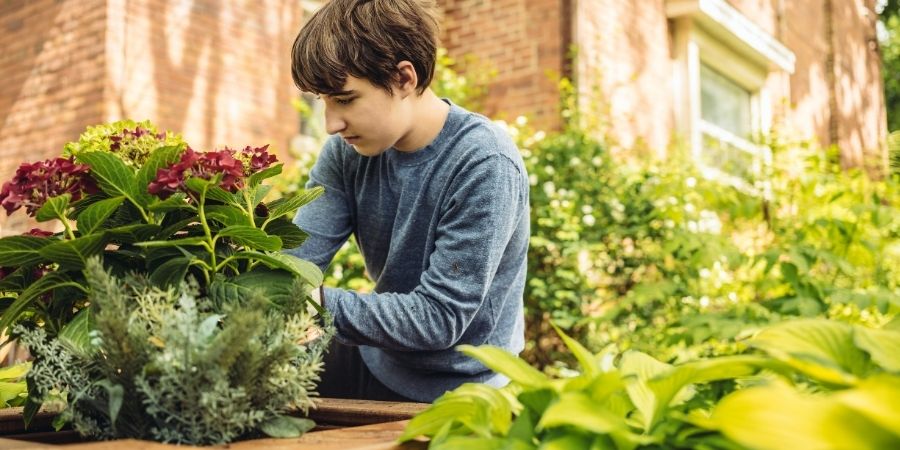How to Get Kids Interested in Lawn Care & Gardening
- Milorganite AgronomistMay 1, 2021
The sooner you get your kids involved in yard and garden activities, increases the likelihood they will develop a life-long appreciation not just for lawns and gardens, but of nature and the environment. Approach yard and garden tasks as fun, family activities rather than chores. The entire family enjoys the yard and everyone can lend a helping hand, at their own level, to maintain it. It teaches kids responsibility and unplugs them from screened entertainment in exchange for outdoor activities.
I was raised in a gardening family. My grandparents were from Poland and they grew an abundant garden on their city lot. My mom continued the practice of growing an extensive garden when my brother and I were children. I’m grateful we grew up with gardens in the yard and the harvest that followed.
We have three boys who are 10, 12, and 14 years of age. As a parent, I want to teach my boys about caring for a lawn and garden, not just because I’m in the field. It allows me to teach them about the environmental benefits of a healthy lawn and, for us, eating fresh produce.
Children learn multiple life lessons while exploring back-yard nature, and that will serve them well as adults: responsibility, work ethic, pride in their successes, learning from mistakes, improved self-esteem, independence, teamwork, and decision making. There are many more, but for these reasons alone, getting your kids in the yard has multiple benefits.
Mike B. of Amherst, New Hampshire, approaches maintaining their lawn and garden as a family activity and he regularly shares his passion with his three kids. “My daughter is our oldest, she’s 7, my sons are five and two-and-a-half. We also have one on the way! I feel it’s absolutely important for children to learn about lawn care and gardening. Understanding what it's like to take care of the land, to know where things come from, and how things work is critical in the world we live in today.”
“I also think it can foster great minds in youth. It shows that hard work does pay off. And it gets them closer to nature, which is something kids today see less of due to how much access we have to technology.”
Mike and his family are very active and take full advantage of their land. “We use the yard to its fullest. Soccer, football, baseball, frisbee, dancing, fires at the fire pit, and we have a swing set.”
To get kids involved, Mike suggests they shadow your activity. “Kids watch what you do. Have them help in any way they can.” Start with small, achievable tasks, such as pulling a few weeds. “’Hey! Pull out that weird looking weed over there.’ I like to have my kids follow me around in the yard and make sure they have fun when you hand them their small rake or shovel.”
“My daughter loves planting flowers. My middle son is mostly interested in mowing and fertilizing. And our youngest loves the grass!” Anticipating the arrival of their fourth child, his or her interests may round out the family’s yard and garden crew.

Mike B.'s Lawn in Amherst, New Hampshire
Age-appropriate and maturity-appropriate yard and garden activities
“Age-appropriate” isn’t the same as “maturity-appropriate.” I consider both when deciding what activities are appropriate for each of my boys. Following is a general breakdown of what you can expect of your children from preschoolers to early teens provided by KidsGardening.org.
Preschoolers, Ages 3-4
Gardening is digging. Allow kids to explore the yard and garden with you and tell them stories about plants, the cycle of life, the environment, and gardening along the way. Manage your expectations. Gardening at this age is digging a hole or moving mulch around. Allow them to take the lead.
Kindergartners, Age 5
Gardening is playing. At this age, gardens are magical locations where imaginations play out. Continue to follow their lead and talk about what they discover. Allow them to create their own world. Dedicate a bit of land of their own. Follow their lead as they explore, dig, create and discover.

Early Elementary School, Ages 6-7
Look for opportunities to incorporate their developing math and reading skills. Read seed packets. Make plant markers. Purchase plants. Doing remains more important than the results. “Soil, holes, and water hold endless fascination, as do bugs.” Gardens are meant to be explored.
Middle Elementary School Ages 8-9
Gardening promotes pride at this age. “The emphasis shifts from doing to doing well.” Dovetail expanding academic skills with gardening. Design a garden on graph paper. Select and consider a plant’s growing needs (planting distance, water, sun, drainage). The plan can be used to guide the creation of their garden.
Late Elementary School/Tweens, Ages 10-11
Gardening makes academics real. Gardening reinforces what they’re learning at this age, including science, math and art. Have them participate in community gardening projects to learn more about gardening and the importance of community support. Their garden skills may now include building simple structures for their garden, such as a trellis for pole beans.
Early Teen Years, Ages 12-13
Gardening may be sidelined. Friends may replace gardening at this age. Yard and garden maintenance will benefit from being a family activity rather than a stand-alone chore. Participate together in additional gardening-related community projects.
Tools and Equipment
Age-appropriate yard and garden tools will help children safely learn how to use each. “We made sure the kids have kid-sized tools, like shovels, rakes, play mowers, etc. to help with the garden.” Other tools may include a trowel, a watering can, and a cap or hat. Switch out their equipment as they age.
Provide safety equipment that fits each child, such as garden gloves and goggles for older children using the lawnmower. Don’t forget: Your children are watching you! It’s critical to instill proper safety from a very young age. You have to model the behavior you’re teaching. If you’re telling your child to wear goggles while they mow, you better be wearing goggles when you mow. I wouldn’t be surprised if one of your children calls you out for not doing what you’re teaching them to do to be safe. Safety is up to you.
Make it fun!
Make time in the yard and garden fun. Make pulling weeds a game, for example. You can teach them the difference between plants we want in the garden and those we don’t while challenging them to pull as many of the same kind of weed they can find. Or give them a small cup to fill. Offer a penny per weed pulled, which becomes a lesson in counting and money. To make weed pulling easier, make sure the soil is moist.
Timed activities
Children don’t have long attention spans. Time activities. Pull weeds for 15 minutes then play for 15 minutes before returning to the same task. Or use rewards, such as a lemonade or popsicle break.
LAWN CARE
Even the youngest greens keeper in your family can help with lawn care. Make it a game to see who can pick up the most debris in the yard, for example. Allow them to do what you’re doing, only on a smaller scale.
How do I know when it is time to let my kids mow the lawn?
The American Academy of Pediatrics recommends children should be at least 12 years of age to operate a walk-behind power or manual mower safely, while others say a 10-year-old is physically able to use a power mower. Wait until your child is 16 before allowing them to operate a riding mower. They stress the importance of teaching kids how to use a mower, as well as safety precautions while mowing. Proper safety equipment while mowing includes long pants, closed-toe shoes, eye protection, and gloves.
Age is a helpful guide for determining an appropriate type and level of lawn and garden activities, but that doesn’t explicitly consider a child’s maturity—a factor we considered before we allowed our two-oldest sons to get behind a mower.
My boys are typical. They’re not so much interested in mowing the lawn as they are in using the mower. We allow our two oldest—12 and 14—to use the push mower. Whenever they’re mowing, either my husband or I am out watching them the entire time. We’ll keep watching until we feel comfortable. This summer we’ll see if my oldest boys graduate to the riding mower. (They have a dream of being millionaires when they’re finally able to use the riding mower to maintain our neighbors’ lawns.)
Safety
Every aspect of safety should be considered while introducing your kids to yard and garden activities. Safety includes tools, machinery, as well as products you use on your lawn and garden, such as fertilizer, herbicides, and pesticides.
Teach kids about the power equipment you use, such as the mower, blower, edger, and other power equipment used in the yard and garden so they also understand safety precautions for each.
When mowing, teach your children to keep a safe distance from the mower. Maybe they can mow their chunk of the lawn. (Although toy mowers don’t accomplish much.)
Choose products that are safe to use around kids and pets
If your yard and garden are frequented by kids and pets, use products that are safe to use around them. Although your kids might not be ready to throw down a 32 lbs. bag of Milorganite themselves, you can explain why you’re using it and talk about safety.
We live on a lake, so I taught my boys about nutrient runoff, the importance of maintaining a strong root system that’s able to utilize the nutrients. They don’t care much about the fertilizer part, but they know mom works for a fertilizer company and that Milorganite is safe to use. They understand that when we apply Milorganite they don’t need to worry about playing in the yard.
I teach them that fertilizer is necessary and that there are differences between synthetic and naturally derived fertilizers. I want them to understand why we approach lawn maintenance the way we do and why we try to use as many natural products as possible.
My boys were very aware when their baseball team had their field treated. We all noticed the little signs and the smell. According to the sign, the herbicide was sprayed just a few hours before the baseball game and we were still not supposed to be on the lawn. They noticed the smell, looked at the sign, and began to ask me if they should even be playing! (They are listening!)
Mike also trusts Milorganite is both safe and effective fertilizer.
“I have firsthand seen the results Milorganite can produce. What makes me so happy about the product is that I can “throw ‘er down,” as Allyn Hane would say, and not have to worry about the lawn burning or my kids getting sick from a random chemical. There’s something to be said about a brand that has 90+ years of experience providing results. I’m a sales leader at work, so it’s all about results! I trust few products. Milorganite is my go-to fertilizer!”
GARDENING
Gardening helps kids connect what grows to what they eat. My boys are into gardening and enjoy the entire process: selecting, growing, maintaining, picking, and eating what they harvest.
To get kids interested in gardening, they have to have ownership. When we shop for plants, I let them pick the vegetables and fruit they want to grow—in addition to what I want to grow. It keeps them engaged throughout the season. We have a strawberry patch, for example, and if some of the plants don’t come back, it’s the boys’ decision as to what variety of strawberry they want to grow as a replacement.
One season they decide they wanted to grow pumpkins. It wasn’t my first choice, but it also wasn’t my decision. They were used to going to a pumpkin farm every year and getting one to carve. They had no clue that they could grow pumpkins in the garden.
When it’s their responsibility, they’ll take an interest in watering and picking the harvest. Although, one thing you’ll likely notice is that each child tends to and waters their plants, not their siblings’.
Kids are more inclined to try new veggies and fruit when they grow them. My boys refuse to eat salad if I buy lettuce from the store, but they’re more than willing to eat what they grew! They’re proud of their tasty accomplishments.

Give them their own space
Carve out a corner of the yard or part of the main garden as their own, a small raised bed or a few five-gallon buckets with a few holes punched in the bottom and filled with soil.
If they’re helping you pull weeds, have them pull the weeds in their garden so it’s not overwhelming. Or designate a small area in the larger garden.
Plant a theme garden
Planting a theme garden provides some structure and helps to focus on what plants are needed.
Pizza garden
Grow the produce typically found on pizza: tomatoes, basil, oregano, onions, peppers, basil, and oregano. You might even want to try growing wheat. Create a round garden and arrange plants in pie slices. At harvest time, bake a pizza.
If you’re interested in growing mushrooms for your pizza, that’s an indoor activity that requires a dark location and time. There are kits available online and are very easy and fun to grow.
Salsa garden
I’ve planted salsa gardens with my boys—all the ingredients you need to make the salsa: tomatoes, peppers, onions, and cilantro. (Maybe a cross-over pizza/salsa garden?) Growing the produce used in something we normally purchase at the store connects what we grow to what we eat.
Salad garden
Greens are fairly easy to grow. You can even grow some on a sunny window sill in colder months. Consider spinach, green and red leaf lettuce.
Adventure garden
Grow plants that spark the imagination. Six-foot sunflowers are impressive at any age, especially when you’re much closer to the ground. Build a kid-sized “tunnel” of chicken wire or similar material. Grow pole beans to cover the tunnel. Beans will hang down where short arms can easily reach them. Gourds are another vining plant that would work well.

